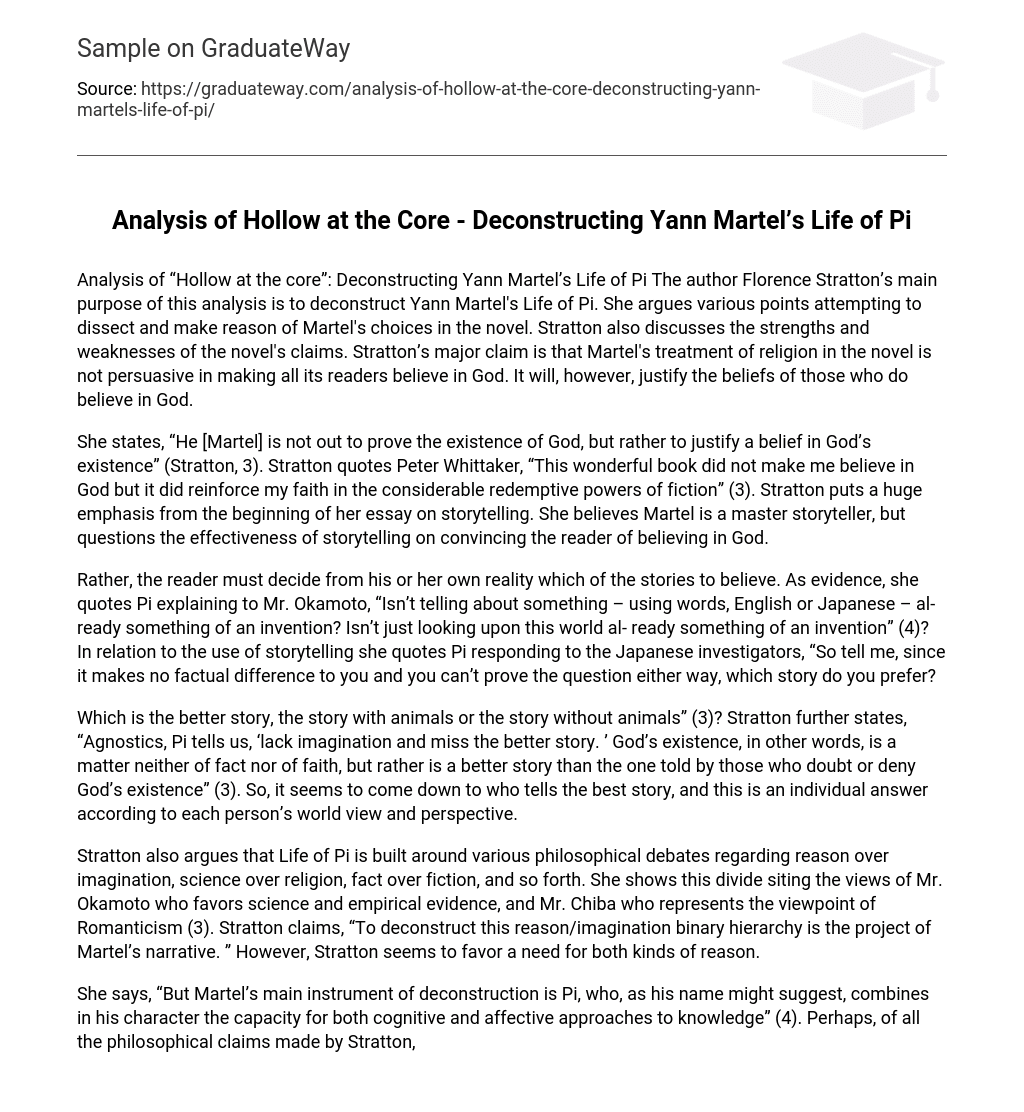In her analysis titled “Hollow at the core,” Florence Stratton aims to deconstruct Yann Martel’s Life of Pi, focusing on evaluating its strengths and weaknesses by dissecting Martel’s choices in the novel. Stratton argues that Martel’s portrayal of religion lacks persuasiveness in convincing all readers to believe in God, but it does provide justification for those who already hold such beliefs.
Stratton argues that Martel’s aim is not to prove the existence of God, but to give a justification for believing in God (3). She cites Peter Whittaker, who asserts that the book enhances his faith in fiction’s ability to redeem rather than making him believe in God (3). Stratton greatly values storytelling and considers Martel as a talented storyteller. However, she questions whether storytelling alone can convince readers to have faith in God.
The reader must decide which stories to believe based on their own reality. Pi argues that using words and language is already a form of invention, and simply observing the world is also a type of invention. In regards to storytelling, Pi asks the Japanese investigators which story they prefer since it doesn’t matter to them and cannot be proven either way.
Which is the superior narrative: the one featuring animals or the one without? Stratton also suggests that “agnostics, according to Pi, ‘lack imagination and miss the superior narrative.’ In other words, God’s existence is not a question of fact or faith, but rather a superior story compared to the one told by those who question or reject God’s existence.” Ultimately, determining which story is better depends on an individual’s worldview and perspective.
Stratton suggests that Life of Pi centers on philosophical debates such as reason versus imagination, science versus religion, fact versus fiction, and more. She supports her argument by highlighting the contrasting views of Mr. Okamoto, who supports science and empirical evidence, and Mr. Chiba, who embodies Romanticism. Stratton posits that Martel’s narrative aims to dismantle the hierarchical divide between reason and imagination. However, she also emphasizes the importance of both forms of reasoning.
According to Stratton, Martel’s primary tool for deconstruction is Pi. Pi, as his name implies, embodies both cognitive and affective approaches to knowledge. Stratton argues that there should be a balance between these two types of knowledge, as each has its own significance. Martel’s narrative suggests that science cannot prevail completely. As Pi declares, “Neither [story] explains the sinking of the Tsimtsum,” showing that there are limitations to scientific explanations.
Okamoto, like Mr. Chiba, chooses the story with animals as the better story, indicating a preference for affective knowledge (4). Martel’s use of realism in his novel is examined by Stratton, who quotes Martel stating that the distinguishing factor between “great” and mediocre fiction is the spark that brings a real story to life (4). Stratton argues that realism aligns well with Martel’s deconstructive intentions.
According to Stratton, the comprehensive documentation required by realism helps to strengthen the imaginative structure or composition of Pi’s “better story” (5). Stratton further illustrates several ways in which Martel incorporates the elements of realism, such as highlighting Pi’s swimming skills, his familiarity with wild animals due to his father’s occupation as a zookeeper, his possession of a whistle (which is typically found in life jackets for life-saving purposes) to train the tiger, and his application of the laws of physics to establish control over the tiger on the lifeboat (5).
In her essay, Stratton (5) extensively delves into Martel’s intricate plot and well-developed characters by exploring their symbolism. Among them, the tiger Richard Parker is examined in great detail, with its name carrying significance due to its victim role in other cannibalistic stories. The narrator’s captivating depiction of Richard Parker allows Stratton to explore the vibrant colors used, which suggest the transcendent power of art and the imaginative truths it encompasses. Contrasting Richard Parker with the hyena, whose description highlights its mismatched colors, ill-proportioned body, and shambling gait (5), further adds depth to Stratton’s analysis.
Moving on, Stratton explores the insatiable appetite of the cook and Frenchman before delving into the link between cannibalism and secular materialism on algae island. She identifies consumer capitalism as the most secular and materialist form of human existence that seems to be directly criticized (5). Additionally, she vividly describes the meerkats on the island as eternal consumers, spending their days nibbling at algae or staring into ponds, eagerly awaiting fresh (dead) fish deliveries (8). Through these examples, Stratton skillfully illustrates Martel’s exploration of profound themes within his work.
According to Stratton, the meerkats’ behavior is completely conventionalized and resembles that of human beings living under late capitalism, as described by Max Horkheimer and Theodor Adorno. Additionally, Stratton argues that the novel portrays the struggle of a religiously devout man to overcome the challenges of material reality. While Stratton links cannibalism to capitalism, some may find it difficult to accept such a direct correlation.
Martel may be exploring the idea of insatiable appetite in connection to Pi’s guilt and his own insatiable appetite with algae island. Stratton argues against the idea that positivism ensures objective meaning between language and the world. There is no definite conclusion on Pi’s two stories. In hindsight, this is a reasonable assumption.





